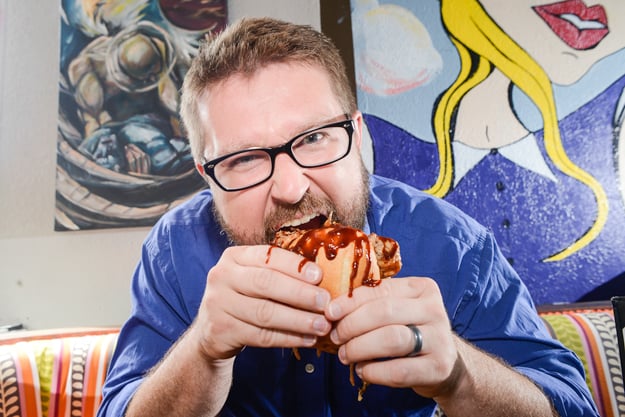Going Whole Hog
A 'cue connoisseur in the making

"No, baby, tell me why don’t you?
Oh, now, baby, tell me why don’t you
Aw, make me some of your fine famous Bar-B-Q?”
– “Bar-B-Q,” ZZ Top
Let’s get one thing straight. Whenever you can quote ZZ Top, you should, especially if it refers to barbecue. And another thing, don’t ever spell it “Bar-B-Q” unless you’re ZZ Top or your beard is of equally impressive stature; for the rest of you, it’s “barbecue.”
North Carolina’s known as the “Cradle of ‘Cue” (also an accepted spelling) and for good reason. Whether you like the tangy, vinegary punch of Eastern-style sauce or the tomatoey sweetness of Western-style sauce or even if you like the anomalous Lexington Dip, whether you like whole-hog, shoulders, butts, or hocks, we do barbecue right.
When I first moved to Wilmington in 2002, I came here from West Virginia via a stint as a middle school teacher in Virginia, and I didn’t know barbecue from roast pork, much less what good barbecue should taste like. I grew up thinking that barbecue was chicken cooked to death over a charcoal grill, slathered in KC Masterpiece that would bubble and caramelize and usually burn (my family is not known for their culinary prowess), or that it was a pork shoulder roasted in the oven and slathered with KC Masterpiece. Do you sense a theme emerging?
It wasn’t until I got to Wilmington that I had good ‘cue. That first bite was at the now defunct, and sorely missed Taste of Country Buffet, and that first bite set the hook deep. This succulent pork that was pulled, chopped, mixed with bits of crispy skin and melty fat, doused with this pungent, peppery, thin vinegar sauce was nothing like any barbecue I’d ever had. It was good.
Since then, I’ve tried a lot of barbecue across North Carolina and even sampled a couple of plates out of South Carolina. I noted the differences, came to understand the superiority of Eastern sauce over Western, but found that I really love the Lexington Dip, which lies somewhere in the middle. When I make barbecue sauce, which I do all the time, doling it out to my friends in mason jars, it’s more Lexington Dip than Eastern or Western.
My quest for good ‘cue and perfection of my own sauce led me to the North Carolina Barbecue Society, a group of pit masters and barbecue nerds from all over. They’re responsible for the state’s Historic Barbecue Trail, which runs from the Skylight Inn in Ayden out to Murphy, deep in the mountains. And they’re responsible for teaching me about proper barbecue and making me a certified judge.
Turns out, most of what I’d eaten, with only one or two exceptions, was roast pork, which is “barbecue” cooked over gas or with electric heat. Once I tasted − and knew how to articulate − the difference, I’ve turned my nose up to fake barbecue ever since. Unfortunately for me, despite having an abundance of barbecue restaurants in the Wilmington area, from Casey’s to Flip’s to Smoke to Jackson’s Big Oak to Duke’s Old South BBQ, nearly every one of them cooks roast pork and calls it barbecue. (I’ll not say who’s the true barbecue joint. You’ll just have to try them, ask the pit master what wood they cook over, and figure it out for yourself.)
As a foodie, food writer, pretty good cook, and barbecue judge (I have a certificate to prove it), I’m desperate to get behind a judging table and use what I know to establish the best ‘cue of the contest, but it keeps falling through.
Contests fill up with more-experienced judges, they’re rained out, they just don’t come together, the timing’s off; every time I’m slated to sit in the judge’s chair, something blocks it.
So I’ve resorted to mentally judging the barbecue my friends cook up (usually on a gas grill) and serve in backyard gatherings. I’ll eat their ribs and shoulders, butts, and loins, even the occasional half-hog, but I always measure it against some ideal ‘cue that only exists in my mind.
Its bark (the outer layer of barbecue) is crisp and loaded with smoky flavor; the meat is succulent and pulled apart into long strands that make nests to capture the sauce and dip. It’s whole-hog, and I get to pick it off myself, burning my fingers a little in the process, but it’s worth it.
To view more of photographer Jeff Janowski's work, go to www.jeffjanowski.com.